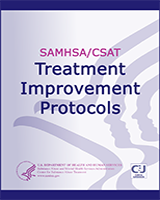NCBI Bookshelf. A service of the National Library of Medicine, National Institutes of Health.
This publication is provided for historical reference only and the information may be out of date.
The purpose of this TIP is to give practical ethical and legal advice to alcohol and other drug (AOD) treatment providers about cooperating with public health officials and others in preventing the transmission of tuberculosis (TB) in AOD treatment facilities. Given that not all AOD programs are alike -- physically, demographically, or in terms of the services they provide -- and given that the risk of TB varies from one program to the next, it is not assumed that everything in this document will be relevant or useful for all treatment providers. Nevertheless, to the extent that all AOD providers have an interest in stemming the spread of TB in their facilities, and to the extent that all AOD providers operate under similar ethical and legal obligations, it is hoped that this document will 1) illuminate some of the more important issues raised by the threat of TB in the AOD setting; promote collaboration between AOD treatment providers and others in the fight against TB; and 3) lead to a safer AOD work place. Toward that end, this TIP will set forth basic information about tuberculosis, explain how AOD treatment providers and others can collaborate without violating Federal laws regarding the confidentiality of alcohol and other drug abuse treatment records, outline the TB-related services required of most substance abuse treatment providers, and discuss steps that substance abuse treatment providers can take to promote safety in the workplace. In keeping with the demanding ethics of the substance abuse treatment field, this document attempts to tell the reader not just what must be done, but what should be done.
Contents
- A Note to Readers
- What Is a TIP?
- Consensus Panel
- Foreword
- Chapter 1—Introduction
- Chapter 2—Summary of Recommendations
- Chapter 3—The Facts About Tuberculosis
- Chapter 4—AOD Programs and Public Health: Joining Together to Fight the Spread of TB
- Chapter 5—Providing TB-Related Services to Patients
- Chapter 6—Toward a Safe Workplace
- How Do We Determine the Risk of TB in a Particular Facility?
- What Should a Program's TB Guidelines Say?
- Who Should Oversee a Program's TB Control Guidelines?
- What Is the Hierarchy of Controls?
- What Can a Program Do To Promote Workplace Safety?
- Programs Must Be Careful Not To Discriminate Against the Disabled
- Programs Must Observe Confidentiality as to Employee Health and TB-Related Information
- Appendix A—Bibliography
- Appendix B—Legal Questions and Answers Regarding TB-Related Discrimination in the AOD Setting
- Appendix C—Sample Forms
- Appendix D—Massachusetts Policy for TB Control in Substance Abuse Treatment Centers
- Appendix E—A Massachusetts Pamphlet on HIV and TB
- Appendix F—A Massachusetts Pamphlet on the Connection Between Substance Abuse and Certain Communicable Diseases
- Appendix G—New York State OASAS Administrative Bulletin on TB Control In Drug Treatment Programs
- Appendix H—New York City TB/Methadone Registry Match Procedure
- Appendix I—New York State Division Of Substance Abuse Services Tuberculosis Update
- Appendix J—CDC: Essential Components of a TB Prevention and Control Program; and Screening for TB and TB Infection in High-Risk Populations
- Appendix K—Federal Resource Panel
- Appendix L—Field Reviewers
This publication is part of the Substance Abuse Prevention and Treatment Block Grant technical assistance program. This publication was written under contract number ADM 270-92-0006 from the Center for Substance Abuse Treatment of the Substance Abuse and Mental Health Services Administration (SAMHSA). Duiona R Baker, MPH, and David L Griffith, MEd, MS, RN, served as the CSAT Government project officers.
The opinions expressed herein are the views of the consensus panel members and do not reflect the official position of CSAT or any other part of the U.S. Department of Health and Human Services (DHHS). No official support or endorsement of CSAT or DHHS for these opinions or for particular instruments of software that may be described in this document is intended or should be inferred. The guidelines proffered in this document should not be considered as substitutes for individualized patient care and treatment decisions.
- The Tuberculosis EpidemicThe Tuberculosis Epidemic
Your browsing activity is empty.
Activity recording is turned off.
See more...
